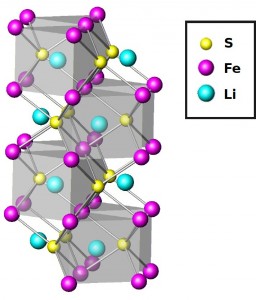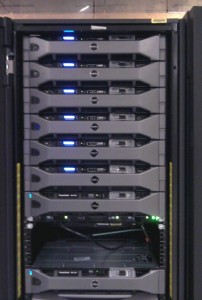[Paper: Electronic localization and bad-metallicity in pure and electron-doped troilite: A local-density-approximation plus dynamical-mean-field-theory study of FeS for lithium-ion batteries. Craco, L; Faria, JLB. J. Appl. Phys. 119, 085107 (2016); http://dx.doi.org/10.1063/1.4942843]
Virtues of a bad metal

Because of their numerous advantages, rechargeable lithium-ion batteries are the most commonly used to power portable electronic devices (smartphones, tablets, laptops…). In addition, these batteries have great potential to be used in electric cars and in other applications.
Motivated by the potential application of iron sulfides (FeS) to be used as electrodes for next generation lithium-ion rechargeable batteries, Luis Craco, professor at the Institute of Physics of the Brazilian Federal University of Mato Grosso (IF-UFMT), undertook, along with his colleague, Jorge Luiz Brito de Faria, a theoretical study on the behavior of troilite (a phase of iron sulfide that is an insulator at ambient pressure and temperature) doped with lithium ions.
In the study, Craco and Faria sought to understand what happened in troilite after the electronic doping – a procedure that can transform an insulator into semiconductor or bad metal by inserting atoms (lithium ions) causing a structural reorganization of the material, by introducing electrons into it.

The work began with a series of calculations by first-principles based on the density functional theory (DFT) performed by Jorge Faria. These calculations use crystal structure data obtained experimentally. Next, Luis Craco carried out a detailed study using calculations based on dynamical mean-field theory (DMFT), to study the effect of electronic correlations between electrons in different orbitals (regions around the nucleus of an atom in which an electron has some probability of being found). In these correlations, a change experienced by an electron in an orbital causes a related change in another electron from another orbital. Correlated electrons act coordinately, although they are spatially separated. According to Luis Craco, “We should bear in mind that the theoretical description introduced in this work is entirely new in the context of troilite and its derivatives, as well as in other compounds containing iron and sulfur as constituent elements”.
In a recently published paper in the Journal of Applied Physics, the professors from UFMT reported a description of the electronic and transport properties of the doped troilite and showed that the material exhibits unconventional behavior. In fact, although the iron sulfide is an insulator even with high concentrations of lithium, their computer simulations showed the emergence of metallic states after high electron doping. Near this insulator-metal transition state, the material can be classified as a Mott insulator. Furthermore, the authors found that the metal states emerged only in certain atomic orbitals, which is the behavior of a bad metal; in other words, a different behavior from that expected from a metal within consolidated theories in Physics.
Being a bad metal, however, does not imply being banned from the overall applications. On the contrary, according to the article, the inconsistent behavior of electrons in the doped iron sulfide can be used to achieve unconventional optical and transport effects within room temperature and pressure.
“This work is a continuing effort involving many researchers in Brazil and abroad, which aims to clearly demonstrate that systems with correlated electrons represent an important class of materials for various technological applications”, said Professor Craco.
“Now we hope the scientific community, related to the physics of correlated electron systems and / or materials physics, for example, becomes aware of our study and results, and that in the near future corroborates our theoretical description of the electronic properties and unconventional transport in electron-doped troilite, thereby consolidating the relevance of our study for future applications of troilite and its derivatives in renewable energy storage or to generate new unconventional non-Fermi liquid electronic phases, with great contemporary scientific and technological appeal”, concludes Craco.
The research was funded by the Brazilian National Council for Scientific and Technological Development (CNPq).
